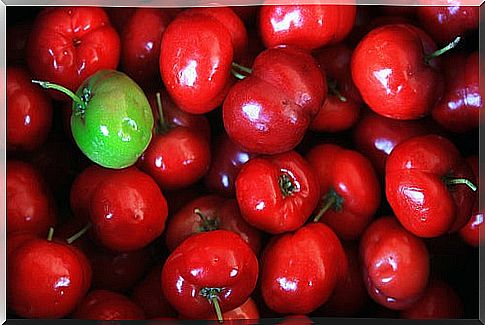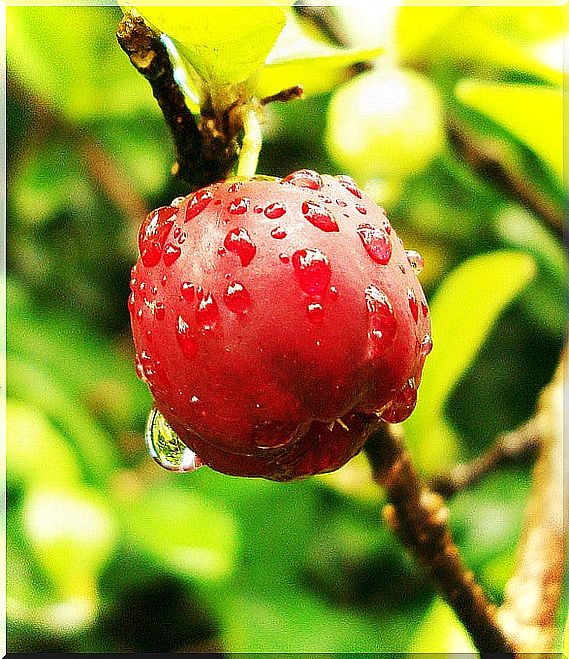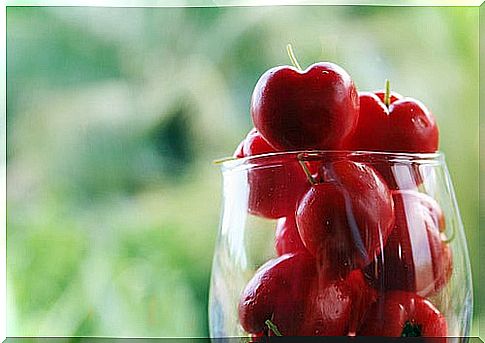The Incredible Benefits Of Acerola

Acerola, also known as Antilles cherry, scientifically Malpighia emarginata or Malpighia glabra , is a fruit originating from the Antilles, Central America and South America.
In terms of size, it is very similar to cherry, and can be red or yellow, with a yellowish interior and subdivided into three seeds with a characteristic bitter taste.
Also, its tree is called acerola tree, and it can measure approximately 3 meters in height.
There are several species of acerola, the caboclas, cherries, apodi, fructocor, olivier and rubra being the most cultivated in Brazil.
An acerola weighs, on average, between 20g and 40g. But don’t let its size and weight fool you, as the health benefits this little fruit can offer are incredible.
Nutritional value of acerola
The acerola hides, in its 40g of succulent mass, numerous nutrients. In addition to flavonoids, vitamins A, B1 and B6 it also contains minerals such as phosphorus, iron, potassium, magnesium and calcium.
Another famous component of acerola is the carotenoid, a substance responsible for the red color of the fruit. In addition, the fruit is also considered an antioxidant, which indicates that it helps prevent premature aging of cells.
But its beneficial components don’t stop there. Surprisingly, acerola is the fruit with the highest vitamin C content.
Thus, some varieties of this fruit reach up to 5,000 ml of vitamin C per 100g of pulp. Still within statistics, acerola has 100 times more vitamin C than lemon, 20 times more than guava and 10 times more than cashew or blackberry, for example.
In other words, consuming 3 to 4 berries of these can meet an adult’s daily requirement for vitamin C.
It is noteworthy that the greener the fruit, the more vitamin C it will offer. That is, a dark green fruit will have 90% more vitamin C and 50% less sugars.
Also, if we compare acerola and orange, we will discover something interesting, as acerola has more vitamin A than orange.
This vitamin is responsible for preventing diseases such as night blindness. Thus, the recommended daily amount of vitamin A is 900 micrograms for men and 700 micrograms for women.
In this sense, while orange offers us 20 micrograms of this vitamin, acerola emerges as the champion in quantity, with 76 micrograms.

But how does all this influence the properties of the fruit? Let’s see.
acerola properties
– As the fruit with the highest vitamin C content, acerola has antioxidant properties, in addition to stimulating the synthesis of collagen, a fundamental component for maintaining the health of bones and connective tissues.
– It also combats fatigue, nervous exhaustion and stress, in addition to having anti-infective properties, which help to stimulate the body’s defenses.
– Due to its richness in minerals, acerola is a good remineralizer. That’s because its high concentration of flavonoids and anthocyanins give it antioxidant properties, making it effective in preventing heart disease and cancer.
– It is indicated to assist in cases of lung affections, treatment of dysentery, wound healing, flu, nose and gum bleeding, muscle pain, rheumatism, anemia, liver disease and diets for people recovering from physical wear and tear, for example .
An energetic and healthy breakfast with acerola
Due to its beneficial nutrients, it is possible to prepare an energetic and healthy breakfast, ideal for adults, children and very suitable for people recovering from trauma, surgeries, etc.
Although there are several ways to consume the fruit, the most popular is to prepare a juice, which has a very easy recipe. For this you will need:
- 1 cup of washed acerola (250ml)
- 1 glass of ice cold water (250ml)
- 2 scoops of any sweetener of your choice (opt for natural sweeteners)
Preparation
Beat the acerola with water in a blender until the pulp comes off the seed (less than 1 minute), then strain the juice.
Return to a blender with the juice, add the sweetener of your choice, then blend for another two minutes.
Just remember that the juice must be consumed immediately as it loses all its properties if stored.

If you prefer a different recipe, write down:
- 1 low-fat natural yogurt
- 1 teaspoon of honey
- 6 strawberries
- 3 teaspoons of oat flakes
- 2 chopped walnuts
- 2 scoops of acerola powder or 10 – 12 fresh fruits
Preparation
Mix the honey, acerola (or powder) and yogurt until the mixture becomes smooth and homogeneous. Then add the oat flakes, clean, chopped strawberries and peeled walnuts.
Acerola can be found in pulp or powder. As it is a very heat-sensitive fruit, it requires great care in handling and storage. However, to enjoy all its benefits, nothing better than fresh fruit.
If you live somewhere where planting is possible, this is undoubtedly a better option. Planting acerola can be a simpler task than it sounds. See a little more about the subject:
Contraindications
The consumption of acerola is generally not associated with major problems, even though it can sometimes have mild side effects, such as nausea, stomach cramps, diarrhea, drowsiness or insomnia.
But it is noteworthy that acerola can cause problems if consumed by people who use anticoagulant drugs.
It is best to reduce or avoid its consumption during periods of pregnancy or lactation, as its effects on the development of the fetus are unknown.
Thus, the same caution is valid in cases of kidney stones, kidney disease or gout.









